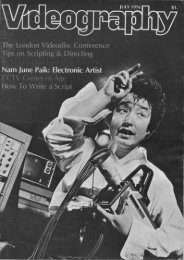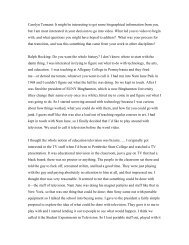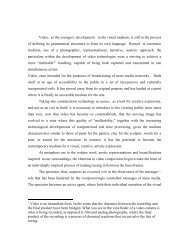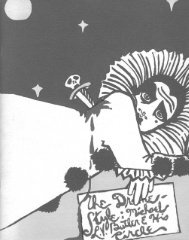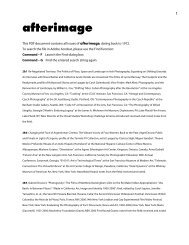At Arm's Length: (Taking a Good Hard Look at) Artists' Video
At Arm's Length: (Taking a Good Hard Look at) Artists' Video
At Arm's Length: (Taking a Good Hard Look at) Artists' Video
- No tags were found...
You also want an ePaper? Increase the reach of your titles
YUMPU automatically turns print PDFs into web optimized ePapers that Google loves.
Vostell (in Cologne in 1959, remounted in New York in 1963) and Nam June Paik(Wuppertal, 1963 and New York, 1965) which incorpor<strong>at</strong>ed television sets into artworks.These artists' fascin<strong>at</strong>ion with television and their simultaneous rejection of it (Paikdistorted the images; Vostell broke, daubed with paint and even shot <strong>at</strong> the sets) were soon tobecome familiar concerns for many cre<strong>at</strong>ors.As video art has developed, many writers, including numerous artists, haveaccepted and asserted video's essential opposition to television. For some, this is an article offaith, as it was for the artist and critic Douglas Davis back in 1970: "The gre<strong>at</strong>est honor wecan pay television is to reject it" (Davis 1978: 33). Others are equally emph<strong>at</strong>ic, if a littleless blunt. In a recent study of artists' video, the Dutch critic Rob Perree st<strong>at</strong>es, "There is afundamental incomp<strong>at</strong>ibility of interests and principles between the artist and the televisionmaker" (Perree 1988: 53). And the cur<strong>at</strong>or K<strong>at</strong>hy Huffman writes in 1984, "<strong>Video</strong> art isfundamentally different from broadcast television and has been since its inception. Wherebroadcast television addresses a mass audience, video art is intensely personal—areflection of individual passions and consciousness" (Huffman: 1984).These comment<strong>at</strong>ors, along with many others, speak of television as if it were amedium defined by a single essence. They fail to recognize th<strong>at</strong> their remarks draw on onlyone conception of the medium. This conception, unsurprisingly, is derived fromunderstandings of the model of commercial network television in the United St<strong>at</strong>es in the1960s and 1970s, and from the particular intellectual clim<strong>at</strong>e of the time, which wasbroadly antagonistic to popular culture.3





